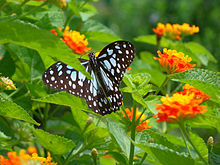Tirumala limniace
| Blue tiger | |
|---|---|
 |
|
| Scientific classification | |
| Kingdom: | Animalia |
| Phylum: | Arthropoda |
| Class: | Insecta |
| Order: | Lepidoptera |
| Family: | Nymphalidae |
| Genus: | Tirumala |
| Species: | T. limniace |
| Binomial name | |
|
Tirumala limniace (Cramer, [1775]) |
|
| Subspecies | |
|
See text |
|
 |
|
| Synonyms | |
|
|
See text
Tirumala limniace, the blue tiger, is a butterfly found in India that belongs to the crows and tigers, that is, the danaid group of the brush-footed butterfly family. This butterfly shows gregarious migratory behaviour in southern India.
Upperside black, with bluish-white semihyaline spots and streaks. Forewing: interspace 1 two streaks, sometimes coalescent, with a spot beyond cell: a streak from base and an outwardly indented spot at its apex; a large oval spot at base of interspace 2, another at base of interspace 3, with a smaller spot beyond it towards termen; five obliquely placed preapical streaks, and somewhat irregular subterminal and terminal series of spots, the latter the smaller. Hindwing: interspaces 1b, 1a, and 1 with streaks from base, double in the latter two, cell with a forked broad streak, the lower branch with a hook, or spur-like slender loop, at base of 4 and 5 a broad elongate streak, and at base of 6 a quadrate spot; beyond these again a number of scattered unequal subterminal and terminal spots.
Underside: basal two-thirds of forewing dusky black, the apex and hindwing olive brown; the spots and streaks much as on the upperside, Antennae, head and thorax black, the latter two spotted and streaked with, white; abdomen dusky above, ochraceous spotted with white beneath. Male secondary sex-mark in form 1.
Wingspan 98–106 mm.
The butterfly larva generally feed on plants of family Asclepiadaceae. The recorded host plants are:
Yellowish white; 3rd and 12th segments, each with a pair of fleshy filaments, black and greenish white; each of the segments with four transverse black bars, the second bar on all broader than the others, bifurcated laterally, a yellow longitudinal line on each side; head, feet and claspers spotted with black. The larva is around 1.21 centimetres (0.48 in) in length and weighs around 5 milligrams (0.077 gr) initially, but grows double that size and four times that weight within 48 hours.
"Green with golden scattered spots and beaded dorsal crescent". (Frederic Moore quoted in Bingham)
South Asia and Southeast Asia.
Listed alphabetically:
This species migrates extensively during the monsoons in southern India. The migratory populations have been observed to consist nearly entirely of males. It is also known to mud-puddle during migration.
...
Wikipedia
